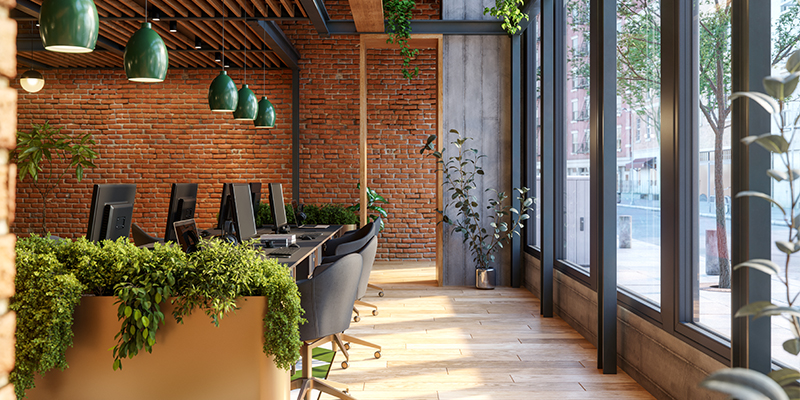Since the start of the pandemic, sleepy small towns and suburbs have taken on new luster as people have migrated en masse from the urban core, drawn by the lower cost of living and with the flexibility afforded by increased remote work options. Will this be the new normal, or will people move back to the major metropolises once we put the pandemic behind us? What does it mean for office real estate in the short and long term?
In a recent NAIOP webinar, experts from Marcus & Millichap shared their research and insights into how these trends are shaping the investment landscape for urban and suburban office spaces. They began by examining the broader economic context underlying the urban to suburban shift before discussing recent office sale trends, the impact of demographics and what’s ahead for this sector.
U.S. Office Supply and Demand Trends
Office vacancy rates have been elevated since the onset of the pandemic; however, office rate absorption has also been positive for five consecutive quarters. “Although it is soft, it is not as soft as some people perceive,” said John Chang, senior vice president, national director research services, Marcus & Millichap. There was only a brief period of net negative office space absorption in 2020 and have been making a recovery, albeit sometimes slowly, since.
Common perceptions of current office market demand are either that no office space is being absorbed or that only Class A office space is being absorbed – both are inaccurate, according to Al Pontius, senior vice president, national director, office and industrial divisions, Marcus & Millichap. The core office segment faces the greatest challenges by the numbers; downtown areas, primary markets, Class A office space all have rising vacancy rates.
Meanwhile, suburban, secondary/tertiary markets, and Class B and Class C office space show better momentum. The absorption largely outside of the urban core marks a behavioral shift as office demand trends change and companies strive to attract and retain employees. According to Marcus & Millichap Research Services and the McKinsey American Opportunity Spring Survey 2022, most workers who can work remotely do so at least some days a week. Only 13% of workers who can work remotely are working in the office full time; meanwhile, 32% work from home full time.
“We still have a very long way to go before we have full attendance at the office, if we ever get back to that point,” Chang said. Until the labor shortage abates, companies face an uphill battle in persuading workers to return to the office. There is a labor shortfall of over 5 million persons, which supports employees having greater say in where they are working, Chang said.
“This is the new normal we’re living in, and I don’t expect the mechanics of this to change in the short term,” Chang said. He added that there are variations in where people are working depending on the type of work, with technology companies leaning toward the work-from-home model, for example, while financial services companies lean toward the work-in-the-office model.
Office Fundamentals: Urban vs. Suburban
The spread between office vacancy rates in suburban and urban areas had already been narrowing ever since 2011, Chang said. The pandemic finally inverted the trend: suburban office vacancies measured below the urban core, which increased higher and faster than vacancies in the suburban core. “For the short to midterm future, I expect this to continue,” Chang said.
This trend is happening across the U.S. and is even more pronounced in secondary and tertiary markets, Chang said.
The cornerstone of this transition is not the pandemic – which accelerated it – but demographic change as the millennial generation enters the family formation stage, Chang said. Millennials have shifted from a live/work/play mentality where they were in the urban core to family formation stages that settle them, in many cases, in the suburbs. We’re seeing a replication of the pattern of the baby boomers in the 1980s, Chang said, following a period of marked demand for urban living from 2010-2015.
Office Sale Trends
“A lot of people believe that the office sector has slowed down, that there’s no activity [in] transactions, and that’s not the case,” Chang said. “When you look at the actual number of deals happening, 2021 was actually a high tide mark with more transactions than any other year. In 2022, the first half of this year has been quite strong as well.”
In terms of dollar volume and how it breaks out by location, suburban office space claims nearly 70% of total dollar volume as of midyear 2022. Chang said that while there is more suburban office space available, he noted that as recently as 2012, the split in dollar volume was closer to 50-50 for suburban and urban office space.
“This conversation is not ‘suburbs win, downtowns lose;’ I think everybody will have their own reformation,” Pontius said. “But we are positive that the suburban trend is far more powerful today than the urban core.”
Much of the millennial population’s movement to the suburbs is driven by their desire to control their own destiny and work with independence, Pontius said.
“I don’t think I’ve ever heard anyone say, ‘I wish I had a longer commute,’” Chang noted. “Especially with unemployment rates so low, employees have the ability to drive that conversation a little bit harder than they have been in the past.”
This is the second of a two-part series. Part one addressed the economic context underlying the urban to suburban shift. Thank you to NAIOP webinar sponsor Majestic Realty Co. Miss the webinar? Access the webinar recording (available for NAIOP members only).














